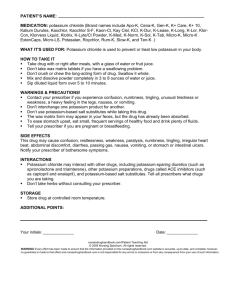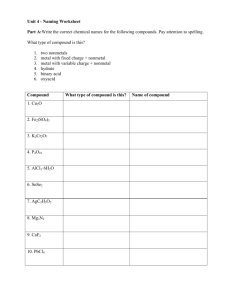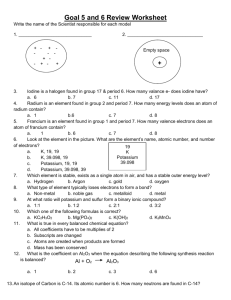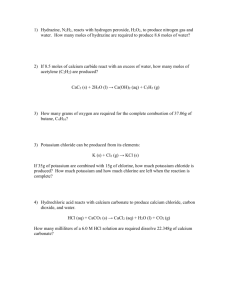File - Ashley N. Hall
advertisement
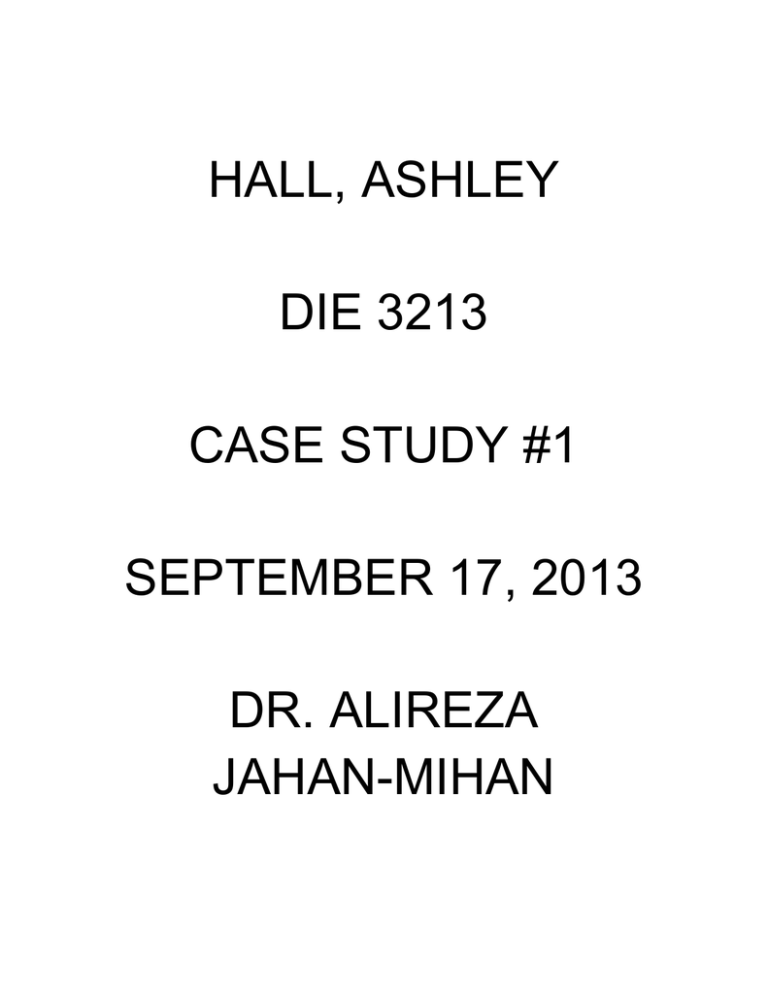
HALL, ASHLEY DIE 3213 CASE STUDY #1 SEPTEMBER 17, 2013 DR. ALIREZA JAHAN-MIHAN Your name Ashley Hall Date September 17, 2013 Case Study #1(Worth up to 50 points) GENERAL NUTRITIONAL ASSESSMENT 1. Convert her height and weight to centimeters and kilograms. Calculate her % IBW, % UBW, and BMI. Interpret her weight and weight change based on these parameters. (5 points) Height = 67 inches = 170.18 centimeters 67 inches x 2.54 = 170.18 centimeters Weight = 140 pounds = 63.50 kilograms 140 pounds / 2.2046 = 63.50 kilograms % IBW = ( current weight / IBW ) X 100 IBW = 100 + 5(7) =135 % IBW = ( 140 pounds / 135 ) x 100 % IBW = 1.037 X 100 = 103.70 % UBW = ( current weight / usual weight ) x 100 % UBW = ( 140 pounds / 160 pounds ) x 100 % UBW = 0.875 x 100 = 87.5 BMI = weight in pounds / ( height in inches )2 x 703 BMI = 140 / ( 67 )2 x 703 BMI = 0.03119 x 703 = 21.93 2. Calculate her nutritional requirements (calories, protein, and fluid) and compare her current intake to her needs. (5 points) Nutrition requirements for a 76 year old female, 140 pounds, and 67 inches Choose my plate: 1600-calorie diet and 5 ounces of protein daily DRI values: 46 grams of protein and 2.7 Liters daily 3. Are any major food groups and nutrients obviously missing from her diet? Explain your answer. (5 points) This plan is a 1600 calorie food pattern. (A 76 year old female, 5 feet 7 inches tall, 140 pounds, physically active less than 30 minutes a day.) 5 ounces 2 cups 1.5 cups 3 cups 5 ounces Most noticeable groups that are missing from the patient diet are the Grains and Dairy. The patient avoid milk because of food preferences so patient need more calcium fortified foods, the only item the patient receives calcium is from the ½ cup of orange juice during breakfast. The required amounts of grains are 5 ounces. The patient need to make at least half of the grains whole grains. 4. Do you think she could be experiencing any drug–nutrient interactions? If so, what dietary suggestions would you make? (5 points) According to the patient’s lab results her values for potassium are 3.2 mEq/L and the normal range for potassium is 3.5 – 5.0 mEq/L. The patient is prescribed Furosemide 20 mg daily. Furosemide is a potassium depleting diuretic and may cause hypokalemia in patients. Hypokalemia is a lower than normal amount of potassium in the blood. A dietary suggestion for the patient is to increase her intake of potassium rich foods in her diet. Since the patient rarely eats or drinks between meals she can select food sources that contain potassium such as a banana or strawberries; or something to drink such as grapefruit or pineapple juice. These items won’t involve cooking for the patient. 5. Interpret her serum albumin and prealbumin. In addition to nutritional intake, what factors can cause these indices to drop? What factors would cause them to be elevated? (5 points) According to the patient’s lab results, her albumin levels were 3.2 g / dL and the normal ranges are 3.5-5.5 g / dL . The patient’s prealbumin levels were 11mg / dL and the normal ranges are 16-40 mg / dL . The patient lost her husband six months ago and lost 20 pounds within that time frame. Albumin levels decrease with aging ( she is 76 years old.) Albumin levels less than the normal range indicate stress and inflammation than overall protein nutrition. Prealbumin levels are often lower in patients that have undergone recent stress or trauma. The loss of the patient’s husband is the stress she has occurred within the last six months. Factors that would cause albumin levels to be increased are when patients are dehydrated and when they are prescribed anabolic hormones and corticosteroids. Factors that cause prealbumin levels to be increased are when patients have renal disease and Hodgkin’s disease. 6. Describe how factors in her anthropometric, biochemical, clinical, and dietary nutritional assessment data all fit together to form a “picture” of her nutritional health. (5 points) From the lab results her potassium is low and looking at her normal diet she is not getting enough of dairy products. The medication she is taking has a side effect of potassium depleting in the body. Consuming more calcium problems can provide benefits for bone health. 7. Write a PES statement based on the nutritional assessment data available. (5 points) Low potassium levels related to potassium depleting diuretics as evidenced by potassium levels 3.2 mEq/L. 8. What dietary and social changes would you suggest to improve her nutritional intake? (5 points) Dietary changes: Increase intake of high potassium foods. Choose healthy snacks to eat on between meals. Make at least half of the recommend amount of grains whole grains. Since patient avoid milk and eggs, add foods high in calcium such as dark green leafy vegetables. Social changes: Be physically active for least 150 minutes each week. 9. What are your nutritional goals for her, and how would you monitor the effectiveness of your interventions from question #8? (5 points) The patient adds a potassium food source three times a week starting Monday. The patient adds a calcium food source two times a week starting in three weeks. To monitor the effectiveness of the goals is to meet with the patient once a week for the first month to follow up on the potassium goals and see if we can increase the potassium rich sources in the diet. Have new labs drawn to see where the patient potassium levels stand compared to the normal ranges. 10. Write a note documenting your assessment in SOAP format. (5 points) S: The patient has low potassium levels. O: Patient levels are 3.2 mEq/L. A: Patient is diagnosed with hypertension and is prescribed a potassium-depleting diuretic. P: See if the prescriber can change the prescribed medication or have the patient increase potassium rich foods to get her potassium levels to at least normal range. References 1. Emery E. Clinical Case Studies for the Nutrition Care Process. Jones and Bartlett Learning;2012:157-160. 2. Daily Food Plans. http://www.choosemyplate.gov/myplate/results.html?name=undefined&age=76&gender =female&weight=140&heightfeet=5&heightinch=7&activity=sed&weightN=126&heightfe etN=5&heightinchN=7&validweight=1&validheight=1&. USDA Choose my plate website. Accessed September 12, 2013. 3. Daily Food Plans. http://www.choosemyplate.gov/myplate/results.html?name=undefined&age=76&gender =female&weight=140&heightfeet=5&heightinch=7&activity=sed&weightN=126&heightfe etN=5&heightinchN=7&validweight=1&validheight=1&. USDA Choose my plate website. Accessed September 12, 2013. 4. Mahan L., Escott-Stump S., Raymond J. Krause’s Food and the Nutrition Care Process. Elsevier; 2012:198.



